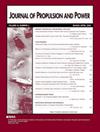实验室规模混合火箭发动机中石蜡/乙醇燃料混合物的性能比较
IF 2.4
4区 工程技术
Q2 ENGINEERING, AEROSPACE
引用次数: 0
摘要
本文讨论了混合火箭发动机中液体乙醇与石蜡的石蜡基混合物与纯石蜡的性能特征。由于液化燃料与传统燃料(如端羟基聚丁二烯(HTPB))相比具有高的回归率,文献中已经报道了许多使用石蜡的研究。尽管纯石蜡的退化速度是HTPB的三到四倍,但它不是发射器应用的理想燃料,原因如下:它不能提供最佳的机械强度,它可能存在燃烧不稳定性,并且燃烧效率低。所提出的混合物是双相的,液体乙醇滴被捕获在石蜡粘合剂中;并采用非离子表面活性剂将乙醇乳化成石蜡。结果表明,在平均预环[公式:见正文]为0.6和[公式:见图正文]为60的情况下,P95E05和P90E10燃料在推力、比冲、燃料质量流量、特征速度和燃烧效率方面与纯石蜡相比没有显著的统计差异。然而,P95E05和P90E10燃料在相对于石蜡的压力振荡中确实表现出阻尼,这表明在石蜡的弹道响应中观察到的低频燃烧不稳定性降低。本文章由计算机程序翻译,如有差异,请以英文原文为准。
Performance Comparison of Paraffin/Ethanol Fuel Blends in a Laboratory-Scale Hybrid Rocket Motor
This paper discusses the performance characteristics of a paraffin-based blend of liquid ethanol with paraffin as compared to pure paraffin in a hybrid rocket motor. Since the disclosure of the high regression rates of liquefying fuels as compared to classic fuels such as hydroxyl-terminated polybutadiene (HTPB), many studies using paraffin have been reported in the literature. Although pure paraffin regresses three to four times faster than HTPB, it is not an ideal fuel for launcher applications for the following reasons: it does not provide the optimum mechanical strength, it may suffer from combustion instability, and it offers low combustion efficiency. The proposed blend is biphasic, with drops of liquid ethanol trapped in a paraffin binder; and a nonionic surfactant was employed to emulsify the ethanol into paraffin wax. The results indicated that at a mean prefiring [Formula: see text] of 0.6 and a [Formula: see text] of 60, both the P95E05 and P90E10 fuels demonstrated no significant statistical difference compared to pure paraffin in terms of thrust, specific impulse, fuel mass flow rate, characteristic velocity, and combustion efficiency. However, the P95E05 and P90E10 fuels did show damping in the pressure oscillations relative to paraffin, indicating a reduction in the low-frequency combustion instability observed in the ballistic responses of paraffin.
求助全文
通过发布文献求助,成功后即可免费获取论文全文。
去求助
来源期刊

Journal of Propulsion and Power
工程技术-工程:宇航
CiteScore
4.20
自引率
21.10%
发文量
97
审稿时长
6.5 months
期刊介绍:
This Journal is devoted to the advancement of the science and technology of aerospace propulsion and power through the dissemination of original archival papers contributing to advancements in airbreathing, electric, and advanced propulsion; solid and liquid rockets; fuels and propellants; power generation and conversion for aerospace vehicles; and the application of aerospace science and technology to terrestrial energy devices and systems. It is intended to provide readers of the Journal, with primary interests in propulsion and power, access to papers spanning the range from research through development to applications. Papers in these disciplines and the sciences of combustion, fluid mechanics, and solid mechanics as directly related to propulsion and power are solicited.
 求助内容:
求助内容: 应助结果提醒方式:
应助结果提醒方式:


